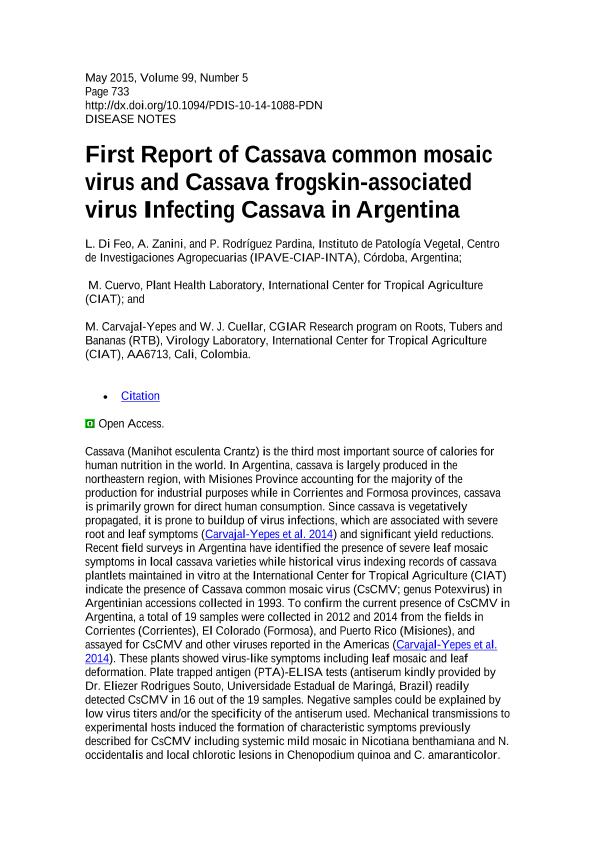Mostrar el registro sencillo del ítem
dc.contributor.author
Di Feo, Liliana del Valle

dc.contributor.author
Zanini, Andrea Alejandra

dc.contributor.author
Rodríguez Pardina, Patricia Elsa
dc.contributor.author
Cuervo, M.
dc.contributor.author
Carvajal Yepesand, M.
dc.contributor.author
Cuellar, W. J.
dc.date.available
2018-11-05T17:49:00Z
dc.date.issued
2015-05
dc.identifier.citation
Di Feo, Liliana del Valle; Zanini, Andrea Alejandra; Rodríguez Pardina, Patricia Elsa; Cuervo, M.; Carvajal Yepesand, M.; et al.; First report of cassava common mosaic virus and cassava frogskin-associated virus infecting cassava in Argentina; American Phytopathological Society; Plant Disease; 99; 5; 5-2015
dc.identifier.issn
0191-2917
dc.identifier.uri
http://hdl.handle.net/11336/63635
dc.description.abstract
Cassava (Manihot esculenta Crantz) is the third most important source of calories for human nutrition in the world. In Argentina, cassava is largely produced in the northeastern region, with Misiones Province accounting for the majority of the production for industrial purposes while in Corrientes and Formosa provinces, cassava is primarily grown for direct human consumption. Since cassava is vegetatively propagated, it is prone to buildup of virus infections, which are associated with severe root and leaf symptoms (Carvajal-Yepes et al. 2014) and significant yield reductions. Recent field surveys in Argentina have identified the presence of severe leaf mosaic symptoms in local cassava varieties while historical virus indexing records of cassava plantlets maintained in vitro at the International Center for Tropical Agriculture (CIAT) indicate the presence of Cassava common mosaic virus (CsCMV; genus Potexvirus) in Argentinian accessions collected in 1993. To confirm the current presence of CsCMV in Argentina, a total of 19 samples were collected in 2012 and 2014 from the fields in Corrientes (Corrientes), El Colorado (Formosa), and Puerto Rico (Misiones), and assayed for CsCMV and other viruses reported in the Americas . These plants showed virus-like symptoms including leaf mosaic and leaf deformation. Plate trapped antigen (PTA)-ELISA tests readily detected CsCMV in 16 out of the 19 samples. Negative samples could be explained by low virus titers and/or the specificity of the antiserum used. Mechanical transmissions to experimental hosts induced the formation of characteristic symptoms previously described for CsCMV including systemic mild mosaic in Nicotiana benthamiana and N. occidentalis and local chlorotic lesions in Chenopodium quinoa and C. amaranticolor. RT-PCR confirmed the presence of CsCMV in the originally collected cassava samples and detected a mixed infection with Cassava frogskin-associated virus (CsFSaV; tentative genus Oryzavirus) in one plant. PCR products from three independent CsCMV-positive samples were cloned into plasmid vectors and sequenced using standard procedures. Sequence analysis of the replicase region of CsCMV obtained using universal potexvirus primers (GenBank Accession No. KP025969) showed a nucleotide identity of 87 and 92% with two Brazilian isolates sequences available in GenBank (U23414 and JF913280, respectively). For CsFSaV, sequence analysis of a conserved region (958 bp) of the segment 4 encoding the replicase gene (KJ742699) detected a nucleotide identity of 88 to 99% with Colombian and Brazilian isolates. Symptoms caused by CsCMV in single infection can reduce yields significantly and although no obvious difference in symptoms was observed in the mixed infected plant detected in this study, the inadvertent accumulation and propagation of additional virus infections could dramatically affect the growing cassava industry in Argentina as it has been occurring in other countries.
dc.format
application/pdf
dc.language.iso
eng
dc.publisher
American Phytopathological Society

dc.rights
info:eu-repo/semantics/openAccess
dc.rights.uri
https://creativecommons.org/licenses/by-nc-sa/2.5/ar/
dc.subject
Virus Disease
dc.subject
Cassava
dc.subject
Argentina
dc.subject
First Report
dc.subject
Characterization
dc.subject.classification
Agricultura

dc.subject.classification
Agricultura, Silvicultura y Pesca

dc.subject.classification
CIENCIAS AGRÍCOLAS

dc.title
First report of cassava common mosaic virus and cassava frogskin-associated virus infecting cassava in Argentina
dc.type
info:eu-repo/semantics/article
dc.type
info:ar-repo/semantics/artículo
dc.type
info:eu-repo/semantics/publishedVersion
dc.date.updated
2018-10-01T15:43:51Z
dc.journal.volume
99
dc.journal.number
5
dc.journal.pais
Estados Unidos

dc.journal.ciudad
St. Paul
dc.description.fil
Fil: Di Feo, Liliana del Valle. Instituto Nacional de Tecnología Agropecuaria. Centro de Investigaciones Agropecuarias. Instituto de Patología Vegetal; Argentina
dc.description.fil
Fil: Zanini, Andrea Alejandra. Instituto Nacional de Tecnología Agropecuaria. Centro de Investigaciones Agropecuarias. Instituto de Patología Vegetal; Argentina
dc.description.fil
Fil: Rodríguez Pardina, Patricia Elsa. Instituto Nacional de Tecnología Agropecuaria. Centro de Investigaciones Agropecuarias. Instituto de Patología Vegetal; Argentina
dc.description.fil
Fil: Cuervo, M.. International Center For Tropical Agriculture; Colombia
dc.description.fil
Fil: Carvajal Yepesand, M.. Centro Internacional de Agricultura Tropical; Colombia
dc.description.fil
Fil: Cuellar, W. J.. Centro Internacional de Agricultura Tropical; Colombia
dc.journal.title
Plant Disease

dc.relation.alternativeid
info:eu-repo/semantics/altIdentifier/doi/https://dx.doi.org/10.1094/PDIS-10-14-1088-PDN
dc.relation.alternativeid
info:eu-repo/semantics/altIdentifier/url/https://www.cabi.org/ISC/abstract/20153229357
Archivos asociados
